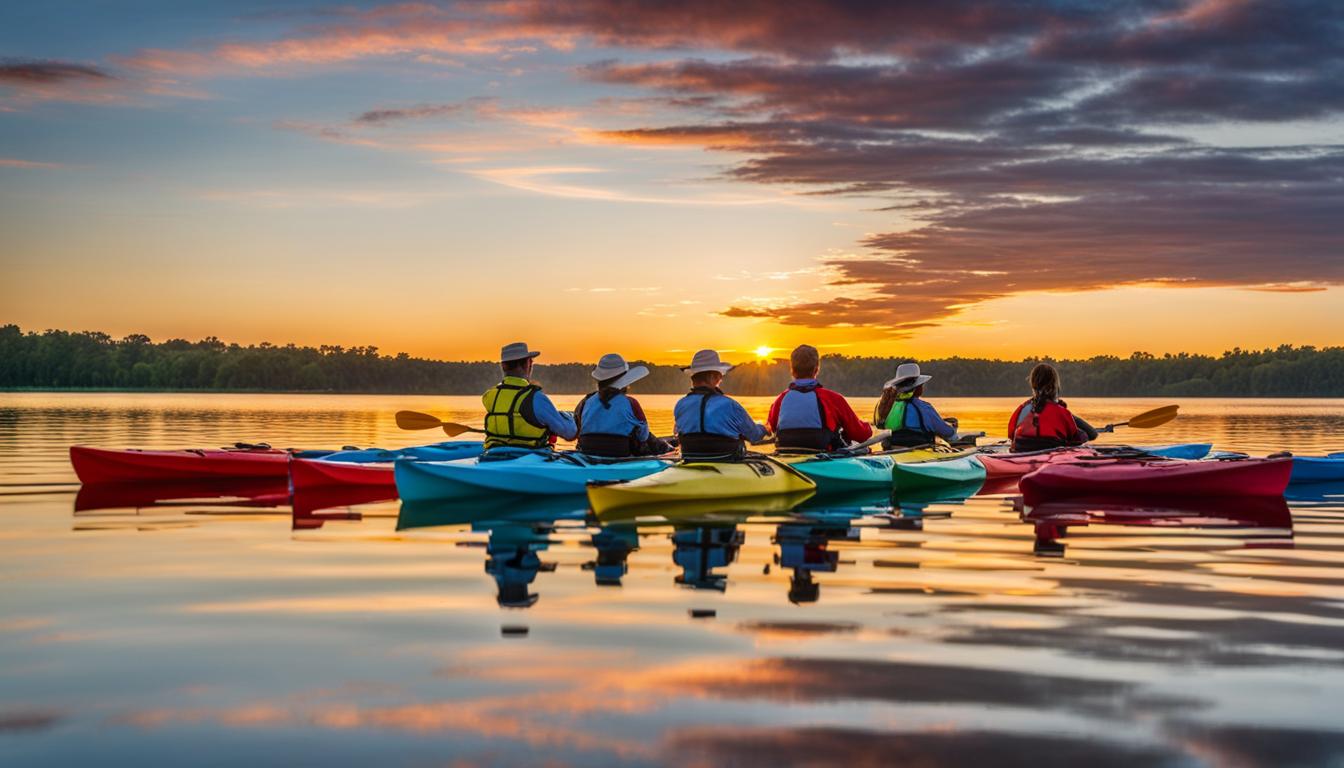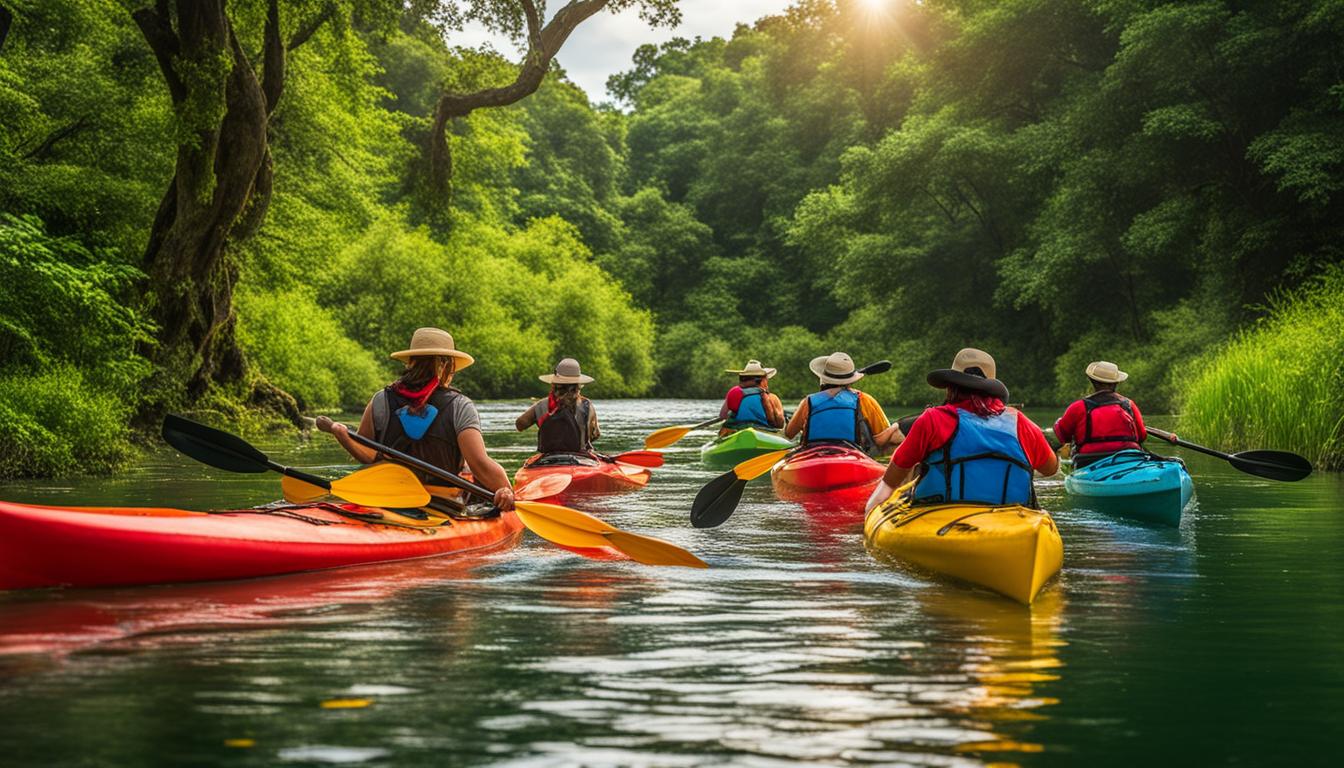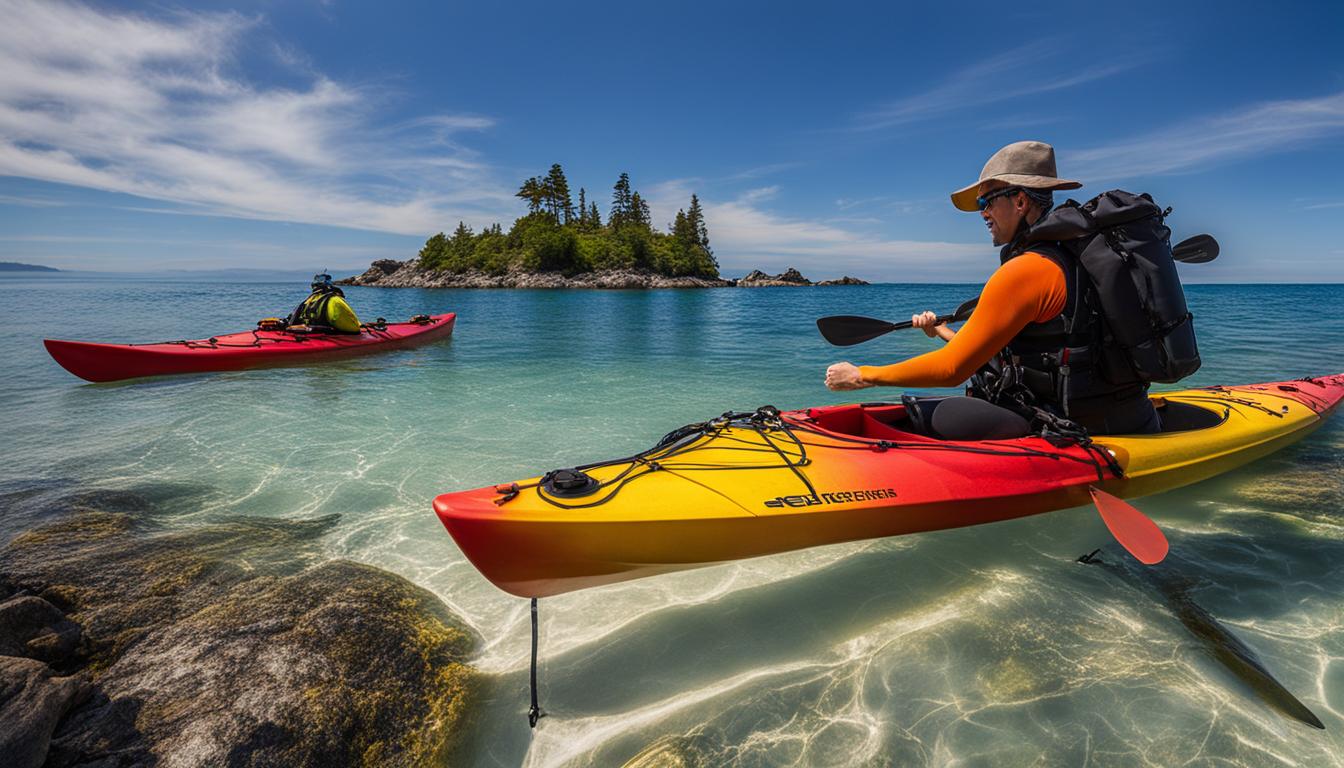Embarking on an overnight kayak trip is an exciting adventure, but getting a good night’s sleep can be a challenge. Limited packing space and unfamiliar terrain can disrupt your comfort. However, with the right strategies, you can maximize sleep quality and ensure a comfortable rest. From choosing compact and lightweight gear to fueling your sleep with a hearty meal, here are some tips to help you sleep comfortably on your kayak trip.
Key Takeaways:
- Pack compact and lightweight sleeping gear to save space and minimize weight.
- Choose calorie-dense foods for a hearty meal that replenishes your energy levels.
- Invest in a supportive pillow to ensure neck support and prevent discomfort.
- Create a comfortable sleeping setup using a hammock or a lightweight backpacking tent.
- Organize your gear in dry bags to keep it dry and easily accessible.
Choosing Compact and Lightweight Sleeping Gear
When embarking on a kayak trip, one of the key considerations for a comfortable sleep is choosing the right sleeping gear. By selecting compact and lightweight options, you can enjoy a restful night’s sleep without compromising on packability or weight. Here are some tips to help you choose the perfect sleeping gear for your kayak adventure.
Compact Sleeping Pads
One of the essential items for a comfortable sleep on your kayak trip is a sleeping pad. Look for compact and lightweight options specifically designed for kayak camping. These pads are often made from durable materials that provide insulation and cushioning from the hard ground. Opt for pads that are self-inflating or have easy-to-use valves, making them convenient to set up and deflate.
Lightweight Sleeping Bags
Another important element of your sleeping gear is a lightweight sleeping bag. Look for bags that offer a balance between insulation and packability. Many kayak camping sleeping bags are designed to be compressible, allowing you to save space in your kayak and still have a cozy sleep. Consider the temperature rating of the bag to ensure it suits the climate of your trip.
Alternative Sleeping Options
If you’re looking for a more unconventional sleeping setup, hammocks can be a great choice. Hammocks are lightweight, easy to set up, and provide a comfortable sleeping surface that keeps you off the ground. Pair your hammock with a lightweight bug net and rainfly for added protection, and you’ll have a cozy and compact sleeping arrangement for your kayak trip.
| Pros | Cons |
|---|---|
| Compact and lightweight | May not provide as much insulation as traditional sleeping bags and pads |
| Easily packable | Requires suitable trees or anchor points for setup |
| Keeps you off the ground | May not be suitable for all sleeping positions |
Choosing compact and lightweight sleeping gear ensures that you have a comfortable and restful night’s sleep during your kayak trip. Whether you opt for a compact sleeping pad, a lightweight sleeping bag, or an alternative sleeping option like a hammock, prioritize packability and weight without compromising on comfort. By considering these factors, you’ll be able to enjoy a good night’s sleep and wake up refreshed and ready for a day of paddling.

Managing Sleep on Kayak Trips
Getting a good night’s sleep is essential for maximizing your enjoyment and performance during kayak trips. Proper sleep management can significantly impact your energy levels, focus, and overall well-being. By following these sleep strategies, you can enhance the quality of your sleep while exploring the great outdoors.
1. Stick to a Routine: Establishing a consistent sleep routine can help regulate your body’s internal clock and promote better sleep. Go to bed and wake up at the same time every day, even during kayak trips. This will train your body to recognize when it’s time to sleep and when it’s time to wake up, leading to more restful nights.
2. Create a Restful Environment: While it may be challenging to recreate the comforts of your bedroom, there are steps you can take to create a peaceful sleep environment on your kayak trip. Use earplugs or noise-canceling headphones to block out any disruptive sounds. Wear an eye mask to block out light if necessary. Investing in a quality sleeping pad or hammock can also provide cushioning and support for a comfortable sleep.
“Sleep is the best meditation.” – Dalai Lama
Table: Sleep Strategies for Kayak Trips
| Sleep Strategy | Description |
|---|---|
| Stick to a Routine | Establish a consistent sleep schedule to regulate your body’s internal clock. |
| Create a Restful Environment | Utilize earplugs, eye masks, and quality sleeping gear to enhance sleep quality. |
| Maintain Physical Activity | Engage in light exercise or stretching to promote relaxation and prepare your body for sleep. |
| Limit Caffeine and Alcohol | Avoid consuming stimulants and depressants close to bedtime to prevent sleep disturbances. |
3. Maintain Physical Activity: Incorporating light exercise or stretching into your daily routine can help prepare your body for sleep. Engaging in physical activity during the day can promote relaxation and reduce restlessness at night. If possible, take a short walk or do some yoga stretches before settling down for the night.
4. Limit Caffeine and Alcohol: While it may be tempting to enjoy a cup of coffee or a relaxing drink in the evening, consuming stimulants like caffeine and depressants like alcohol can disrupt your sleep patterns. Try to avoid these substances, especially in the hours leading up to bedtime, to ensure a more restful sleep on your kayak trip.
By implementing these sleep strategies, you can effectively manage your sleep on kayak trips, maximizing sleep quality and enjoying the full benefits of your outdoor adventures.

Finding the Right Pillow for Neck Support
When going on a kayak trip, getting a good night’s sleep is crucial for your overall comfort and enjoyment. One of the key elements to consider is finding the right pillow that provides adequate neck support. While a large sleep apnea therapy pillow may not be practical to bring along, there are other options that can help ensure a restful sleep.
An inflatable neck pillow is a great choice for kayaking as it offers both compact storage and excellent support for your neck. These pillows can be easily inflated and deflated, taking up minimal space in your gear. The inflatable design allows you to adjust the firmness to your liking, providing a personalized level of comfort.
Another benefit of using a neck pillow is that it helps prevent your head from dropping backward, which can cause discomfort or even snoring. If you or your companions have sleep apnea or snoring issues, using an inflatable neck pillow while sleeping in a hammock can be especially beneficial. The slight incline of a hammock can help alleviate snoring by keeping your airways open and allowing for better breathing.
| Pillow Type | Pros | Cons |
|---|---|---|
| Traditional Pillow | – Provides familiar comfort – Available in various sizes and materials |
– Bulky and takes up space – Heavier to carry |
| Inflatable Neck Pillow | – Compact and lightweight – Adjustable firmness – Provides neck support |
– Requires inflation and deflation – Not as soft as traditional pillows |
| Memory Foam Pillow | – Molds to your neck shape – Offers excellent support – Durable and long-lasting |
– Can be bulky and heavy – May retain heat during warmer nights |
Choosing the right pillow for neck support is essential to ensure a comfortable and restful sleep on your kayak trip. Consider your personal preferences, any specific neck or sleep issues, and the practicality of the pillow for kayaking. With the right pillow, you’ll be able to wake up refreshed and ready to enjoy your day of paddling and exploring.
Creating Comfortable Sleeping Setups on Kayak Trips
When embarking on a kayak trip, ensuring a comfortable sleeping setup is key to getting a good night’s rest. Whether you prefer a hammock or a tent, choosing the right gear and organizing it properly can make all the difference. Here are some tips to create a comfortable sleeping arrangement for your kayak camping adventure:
Choosing a Hammock
A hammock can provide a cozy and elevated sleeping experience, keeping you away from damp or rocky ground. Look for a lightweight hammock that’s easy to set up and pack. Ensure it has a comfortable sleeping surface and consider adding an underquilt or a sleeping pad for insulation and extra cushioning. With a hammock, you’ll enjoy the gentle sway and peaceful sleep while surrounded by nature.
Opting for a Tent
If you prefer a tent, invest in a lightweight backpacking tent that offers protection from the elements. Look for a tent with a comfortable sleeping area and good ventilation. Consider using a sleeping pad or an inflatable mattress to cushion the ground beneath you. Make sure to choose a tent size that accommodates your sleeping needs and offers ample headroom for added comfort.
Organizing Your Gear
To ensure a hassle-free experience, keep your gear well-organized within drybags. This will help prevent moisture from seeping in and keep everything easily accessible. Consider creating a checklist to ensure you have all the necessary items for a comfortable sleep, such as a sleeping bag, extra blankets, a pillow, and any other personal comfort items. By keeping your gear organized, you’ll have more time to relax and enjoy your time on the water.
By choosing a hammock or a tent that suits your preferences, and organizing your gear effectively, you can create a comfortable sleeping setup on your kayak trip. Whether you’re gliding gently in a hammock or nestled snugly in a tent, a restful night’s sleep will ensure you wake up refreshed and ready for another adventure-filled day on the water.
Conclusion
Embarking on a kayak trip is an exhilarating adventure, and getting a good night’s sleep is essential for maximum enjoyment. By implementing effective sleep strategies, you can optimize your sleep quality on kayak trips and wake up rejuvenated to embrace the beauty of nature.
To ensure a restful sleep, focus on packing compact and lightweight gear that won’t weigh you down. Consider alternatives such as thermal aluminum blankets or hammocks, which offer comfort without adding excessive weight to your kayak camping setup.
Fueling your sleep with a hearty meal is equally important. Choose calorie-dense foods that provide a mix of carbohydrates, protein, and vegetables. Don’t forget to bring warm beverages and consider setting up a simple fire pit to keep yourself cozy.
Lastly, finding the right pillow for neck support is crucial. Opt for an inflatable neck pillow that provides adequate support and prevents your head from dropping back. Sleeping in a hammock can also help alleviate snoring and enhance your overall sleep quality.
By prioritizing these kayak trip sleep strategies – packing the right gear, eating well, and investing in neck support – you can ensure a comfortable and rejuvenating sleep on your next kayak adventure. So, get ready to make the most of your time on the water and wake up ready to conquer another day of paddling!
FAQ
What are some tips for choosing compact and lightweight sleeping gear for kayak trips?
Consider using lightweight thermal aluminum blankets or hammocks as alternatives to heavy sleeping bags. Insulate the bottom of your hammock or sleeping pad for added warmth and comfort.
How can I fuel my sleep with a hearty meal on a kayak trip?
Opt for calorie-dense foods that provide a mix of carbohydrates, protein, and vegetables. Replenish your energy levels after a long day of paddling. Consider bringing something warm to drink and setting up a fire pit to heat up your beverages.
What type of pillow should I choose for neck support on a kayak trip?
Instead of a large sleep apnea therapy pillow, opt for an inflatable neck pillow that provides adequate support for your neck and prevents your head from dropping back. This can help alleviate snoring and ensure a comfortable sleep.
How can I create a comfortable sleeping setup on a kayak trip?
Consider using a hammock or a lightweight backpacking tent with a comfortable sleeping surface. A hammock keeps you elevated and away from damp or rocky ground, while a tent provides protection from the elements. Ensure your gear is well-organized within dry bags to prevent moisture and facilitate easy access.
What are some strategies for maximizing sleep quality on kayak trips?
Pack compact and lightweight gear, eat a hearty meal, choose the right pillow, and set up a comfortable sleeping arrangement. These tips will help you prioritize a good night’s sleep while enjoying the great outdoors.





